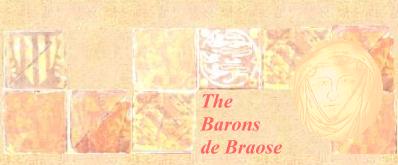
The
Fall

King John's reign was a
continuous struggle to overcome the legacy of Richard, who drained
the treasury to pay for his exploits abroad. John exacted every
toll, tax or fee that his sharp wits could conjure up, to the
outrage of his barons. As John fought and harassed his opposition,
the costs of war increased the tax burden even more. The church
gave moral justification to those who opposed him and bishop
Giles de Braose was prominent among them.
The king started to demand
hostages from his barons. Hostage taking was a common royal tactic
to subdue any dangerous intent and encourage loyalty. Disobedience
or an armed attack put the hostages at risk of mutilation or
slaughter.
Maud de Saint Valery spat
a defiant insult at the king's messengers. She would not hand
her sons over to John, the murderer of his own nephew Arthur!
This stinging challenge clinched the de Braoses' fate. William
de Braose had received royal favour but his insubordinate wife
had voiced a deadly accusation. Few would doubt that it was the
truth. Her husband was in a position to know. Giles' open hostility
seemed all the more dangerous.
The king's favour turned
icy cold. First John called in William's debt of 5,000 marks
for Limerick. He refused to pay. Then at a decisive meeting in
Hereford John confiscated Brecon, Hay and Radnor, also demanding
three of William's grandsons as hostages, to be held until payment
was made. The children were William, son of Reginald, and Philip
and Giles, sons of William, the de Braose heir.
The baron agreed to John's
terms, then immediately launched a rebellion with his sons Reginald
and William. He failed to take his lost castles but burned and
pillaged Leominster. John dispossessed and outlawed William in
1208.

Maud
repented and tried in vain to placate the king. Among her peace
offerings, she sent a
herd of 400 cows
and a magnificent bull to the queen. All of them were milk white
except for their red ears. Terrified by the king's increasing
fury, Maud and William fled to Ireland with their family. They
sought safety with the powerful Marshal family then the de Lacy
brothers, lords of Meath and Ulster. Walter de Lacy of Meath
had married their daughter Margaret in 1200.
In Wales, Gwenwynwyn of
Powys and Llywelyn of Gwynedd were swift to take advantage of
the vast power vacuum caused by the de Braoses' fall. King John
dealt brutally with their rebellion in 1208. He moved to invade
Ireland in 1210 and expelled the de Lacys for harbouring the
de Braose family.
William
made a desperate return to Wales and recruited Llywelyn to his
cause. They fought side by side until John returned to crush
the alliance. The last Welsh princes to submit to John's humiliating
peace terms were Owain and Rhys of Deheubarth,
grandsons of William de Braose through his daughter Matilda's
marriage to Gruffydd ap Rhys.

back to text

back to text
 The Fall |
||||
King John's reign was a continuous struggle to overcome the legacy of Richard, who drained the treasury to pay for his exploits abroad. John exacted every toll, tax or fee that his sharp wits could conjure up, to the outrage of his barons. As John fought and harassed his opposition, the costs of war increased the tax burden even more. The church gave moral justification to those who opposed him and bishop Giles de Braose was prominent among them. The king started to demand hostages from his barons. Hostage taking was a common royal tactic to subdue any dangerous intent and encourage loyalty. Disobedience or an armed attack put the hostages at risk of mutilation or slaughter. Maud de Saint Valery spat a defiant insult at the king's messengers. She would not hand her sons over to John, the murderer of his own nephew Arthur! This stinging challenge clinched the de Braoses' fate. William de Braose had received royal favour but his insubordinate wife had voiced a deadly accusation. Few would doubt that it was the truth. Her husband was in a position to know. Giles' open hostility seemed all the more dangerous. The king's favour turned icy cold. First John called in William's debt of 5,000 marks for Limerick. He refused to pay. Then at a decisive meeting in Hereford John confiscated Brecon, Hay and Radnor, also demanding three of William's grandsons as hostages, to be held until payment was made. The children were William, son of Reginald, and Philip and Giles, sons of William, the de Braose heir. The baron agreed to John's
terms, then immediately launched a rebellion with his sons Reginald
and William. He failed to take his lost castles but burned and
pillaged Leominster. John dispossessed and outlawed William in
1208.  Maud repented and tried in vain to placate the king. Among her peace offerings, she sent a herd of 400 cows and a magnificent bull to the queen. All of them were milk white except for their red ears. Terrified by the king's increasing fury, Maud and William fled to Ireland with their family. They sought safety with the powerful Marshal family then the de Lacy brothers, lords of Meath and Ulster. Walter de Lacy of Meath had married their daughter Margaret in 1200. In Wales, Gwenwynwyn of Powys and Llywelyn of Gwynedd were swift to take advantage of the vast power vacuum caused by the de Braoses' fall. King John dealt brutally with their rebellion in 1208. He moved to invade Ireland in 1210 and expelled the de Lacys for harbouring the de Braose family. William
made a desperate return to Wales and recruited Llywelyn to his
cause. They fought side by side until John returned to crush
the alliance. The last Welsh princes to submit to John's humiliating
peace terms were Owain and Rhys of Deheubarth,
grandsons of William de Braose through his daughter Matilda's
marriage to Gruffydd ap Rhys.
|
||||